

The energy of an Internet search. The energy of an Internet search.
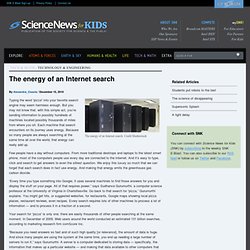
Credit Shutterstock Typing the word “pizza” into your favorite search engine may seem harmless enough. But you may not know that, with this simple act, you’re sending information to possibly hundreds of machines located possibly thousands of miles from where you sit. Kids now getting ‘adult’ disease. When she was 9 years old, Ann Albright went to the doctor with odd flulike symptoms.

She was exhausted. She had to go to the bathroom frequently in the middle of the night. She was always thirsty. Even her vision was blurry. After a few tests, the doctor pulled Albright’s mother aside. “I still remember it very vividly,” says Ann Albright, now more than 40 years later. The verdict: diabetes, a disease that affects the way people process food. At the time, the 1960s, the diagnosis meant that young Ann would never have the carefree childhood her mother wanted for her. “In the era I was diagnosed, most people were told they’d have a shorter life span,” Albright says. Science has come a long way since then, says Albright, partly as a result of her own efforts: She’s now a doctor and diabetes researcher at the Centers for Disease Control and Prevention in Atlanta.
Despite the advances, though, scientists still can’t answer a lot of basic questions about what causes diabetes. Breakdown Two types. What-on-earth-is-diabetes. Making light of sleep. Maybe this has happened to you: In the middle of class, while you pretended to be paying attention to the teacher’s lecture, your eyelids started to droop.
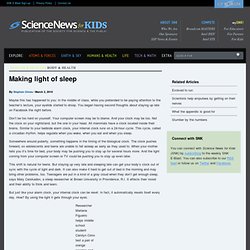
You began having second thoughts about staying up late on Facebook the night before. Don’t be too hard on yourself. Your computer screen may be to blame. And your clock may be too. Settling the Americas. The world was a very different place tens of thousands of years ago.

People didn’t yet inhabit many regions that are crowded today. Scientists have long wondered exactly when people first journeyed far from their homelands to settle all around our globe. The migration route from Asia to the Americas has proved especially mysterious. A new study provides some insight into that route. Until recently, most researchers thought people moved from Asia into the Americas in waves, beginning about 16,000 years ago.
The new conclusions come from analyses of DNA, the genetic material that is passed from generation to generation. Scientists from the University of Florida in Gainesville looked at DNA taken from two groups of modern people: eastern Asians and Native Americans. About 43,000 years ago, results suggest, several hundred people left a harsh environment in what is now eastern Asia. Today, Beringia is covered by a body of water called the Bering Strait. Going Deeper: Women Flying High. Sally Ride, the first American woman in space, sits in the cockpit of a NASA space shuttle in 1983.
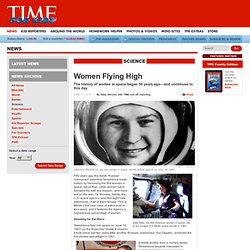
Fifty years ago this week, Russian cosmonaut Valentina Tereshkova made history by becoming the first woman in space. Since then, other women have followed the trail she blazed—and more are on the way. On Monday, NASA, the U.S. space agency, selected eight new astronauts—half of them female. This is NASA’s first new class of astronauts in four years, and it features the agency’s highest-ever percentage of women. Shipwrecked! When Ernest Shackleton packed for his trip to Antarctica in July 1914, he seemed ready for anything.
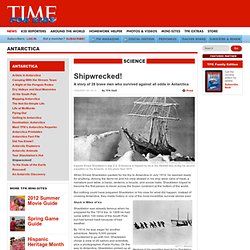
Among the items he and his crew stowed in his ship were cans of meat, a miniature pool table, a banjo, lanterns, a bicycle, and soccer balls. Shackleton hoped to become the first person to travel across the frozen continent at the bottom of the world. But nothing could have prepared Shackleton or his crew for what did happen. Instead of crossing Antarctica, they made history in one of the most incredible survival stories ever.
Members of the expedition team led by Shackleton pull a boat across the snow in the Antarctic in 1914. Stuck in Miles of Ice Shackleton was already famous when he prepared for the 1914 trip. By 1914, he was eager for another adventure. Shackleton’s last stop before heading for Antarctica was a whaling station on South Georgia Island. They were right. Fighting Boredom and Cold The ship was locked in ice for 10 months. A Heroic Rescue. A Meeting of Great Minds. It is no surprise to see why Lindau, Germany, is a popular summer vacation spot.
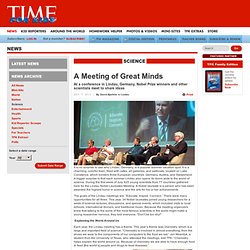
It is a charming, colorful town, filled with cafes, art galleries, and sailboats, located on Lake Constance, which borders three European countries: Germany, Austria, and Switzerland. A bigger surprise is that each summer Lindau also opens its doors wide to the world of science. During the first week of July, 625 young scientists from 77 countries gathered here for the Lindau Nobel Laureates Meeting. A Nobel laureate is a person who has been awarded the highest honor in science and the arts for his or her achievements.